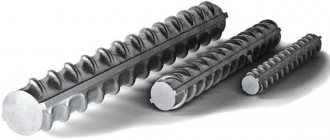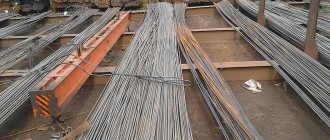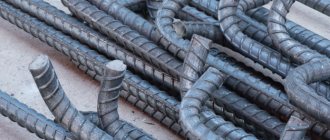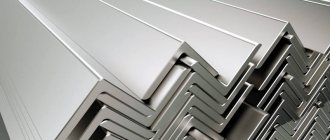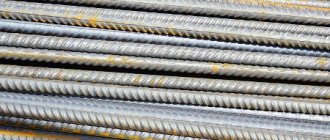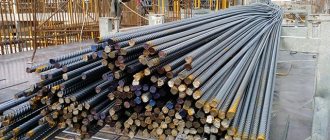In the capital construction of monolithic country houses one cannot do without reinforced structures. At the same time, the majority of costs in the process of purchasing materials mainly fall on fittings. To determine the quality of products, requirements for products according to various parameters, specially developed by Gosstandart, are used. In this type of production, standards are established for the diameter, weight and cross-section of rods. The weight of the reinforcement, calculated accurately and correctly, will help to realistically estimate not only the costs of organizing construction work, but also an important part of the cost of the entire facility. All these characteristics are united by one term - reinforcement range .
This article will tell you in more detail about the set of requirements. Metal corner: range, weight, characteristics, GOST standards (read more)
The reinforcement has established standards for cross-section, weight and diameter.
Scope of application, features of fittings: diameter, classes, markings, compliance with GOST
Reinforcement is an important component in the general list of building materials. It is characterized by a wide range of applications at various stages of building construction. Not a single reinforced concrete structure can do without it, serving as reinforcement and support both in the foundation of a small house and in the construction of a large-scale railway bridge or overpass. Reinforcement technology is even used to strengthen glass structures.
Reinforcement is used in construction at various stages of construction.
Even at the initial stage of developing design estimates, every self-respecting engineer and architect has at hand a special table of the ratios of weight and footage of reinforcement, as well as cross-sections of reinforcing bars in accordance with established state standards. The main one among them is GOST 5781-82. Also, products must comply with GOST 52544-2006, STO ASChM 7-93, TU 14-1-5254-94. The standards regulate the requirements for a specific type of reinforced products. Their totality corresponds to the term – reinforcement assortment.
The fittings are round metal rods with a smooth or corrugated surface. They are made from several types of steel. The diameter of the rods ranges from 4 to 80 mm. The product range is divided into classes A1 – A6.
I-beam: assortment, dimensions, technical characteristics of profiles (read more)
Diameter, that is, the cross-sectional size of a reinforcement bar or wire, is the main indicator underlying the product range. Hence the corresponding terms: reinforcement 8 mm or weight 1 m of reinforcement 12. These products are classified according to other properties, including strength, wear resistance, specific gravity and other characteristics, which we will consider further.
Options for reinforcing right angles and joints
Rebar weight calculator
The corner elements of the strip foundation experience the greatest loads after the building is erected. Therefore, the reliability and durability of the entire structure will depend on how well the reinforcement of these sections of the foundation is done. Simple knitting of longitudinal reinforcement elements at right angles is unacceptable, since this method does not provide additional strength. There are three main methods of reinforcing corner parts and junctions for strip foundations:
First way
The main external longitudinal reinforcement is bent at 90 degrees. The internal longitudinal bars are also bent at 90 degrees and attached with wire to the external longitudinal bars. The size of the bent part of the internal rods should be equal to 50 diameters of the longitudinal reinforcement. The same operations must be carried out at all horizontal levels of the reinforcing frame.
The pitch of vertical (transverse) reinforcement in corner elements and joints should be 0.5 of the main pitch. The same step requirement applies to all other methods of reinforcing corner parts and junctions.
Second way
This method of anchoring at corner joints and junctions for the manufacture of a metal frame is considered the simplest and is often used. If the length of the longitudinal rods is not enough to bend them, L-shaped fastening elements are used. The length of each arm of such elements must be at least 50 diameters of the main reinforcement. The external longitudinal rods are connected by one L-shaped element to each other. Each internal longitudinal element is connected to an external reinforcement bar using an L-shaped element. To reinforce one corner connection, three L-shaped clamps will be required for each longitudinal level of the frame. For the junction, two such elements are required for each level.
Third way
To make the metal reinforcing frame more durable, we install U-shaped elements in the corners and joints. The width of such elements corresponds to the width of the reinforcing frame, and the length is at least 50 diameters of the longitudinal reinforcing bar. These elements are knitted to the main longitudinal rods with the open part of the letter “P” in the direction from the corner. To reinforce one corner, two such elements are required (at each horizontal level), for the junction, one element at each level.
Reinforcement classes: product range by strength and mechanical parameters
The word assortment (or assortment) in French sounds like assortir and means “to select,” that is, to sort into varieties in accordance with typical characteristics.
Reinforcement differs in various parameters, such as dimensions, profile and material for manufacture.
These parameters include:
- material used to manufacture products;
- reinforcement dimensions, such as size, diameter, surface type;
- profile.
On a note! Products are packaged according to their diameter classification. Reinforcing metal products up to 10 mm are sold in coils, and above this parameter they are packaged in rods of a certain length.
Reinforcement is used in construction work in the form of rods, mesh, wire or frame. Based on its purpose, it is divided into structural, anchor, installation or working. This takes into account the presence or absence of tension, as well as the need to strengthen the structure in a certain area. Reinforcement can be longitudinal or transverse.
Reinforcement is also marked and classified according to other characteristic features, but first of all, the diameter of the reinforcement is taken into account, as well as the degree of strength, flexibility and mechanical characteristics. The symbol in the assortment marking is the capital letters A (less often B) with a certain index, which indicates that the reinforcement corresponds to a particular class. We will consider the main and most popular classes of reinforcement in construction in this article.
The fittings are divided into several classes, each of which has its own characteristics.
Related Posts via Categories
- How to calculate the cross-sectional area of reinforcement of all types?
- How much does 1 meter of construction rod reinforcement of various types weigh?
- Length of rod reinforcement - all possible options regulated by GOSTs
- Linear fittings – high-quality installation of power lines is guaranteed!
- Unmeasured reinforcement is the best option for low-rise construction!
- Brands and classes of construction rod reinforcement and wire for reinforcement
- Coupling fittings, what they are and what they are used for
- Anchoring reinforcement in concrete is a complex but important operation
- Hot-rolled reinforcement - GOST and the entire life cycle of the product
- Weight and features of steel corrugated reinforcement A3 and other classes
How to find out the weight per meter of reinforcement with a diameter of 8 mm
Reinforcement assortment table: designations and characteristics of various classes
Even professionals sometimes get confused in construction terminology and markings. Different types of materials, including fittings, have their own classification, which makes it possible to simplify and unify many processes as much as possible.
What is a channel: range, characteristics, areas of application (read more)
A special table of reinforcement classes will help you navigate the classification and labeling. It has a fairly simple and understandable structure, consisting of several columns, where the first is the main marking, and then the corresponding characteristics:
- weight;
- section size or diameter;
- load resistance;
- integration into stressed reinforced concrete structures;
- relative elongation after rupture;
- rod length;
- steel grade.
Reinforcement class A240 has a smooth surface, cross-section from 6 to 40 mm.
The table may contain more extended information, for example, allowing you to calculate the weight of a linear meter of reinforcement or, conversely, calculate how many meters are in a ton of 12 mm reinforcement. For beginning builders, a simplified version with a minimum of background information is suitable.
Channel characteristics: channel weight, size table, cost of profiles (read more)
The class of reinforcement includes several digital and letter designations that determine its strength, size and purpose. At the same time, according to the reinforcement assortment table, GOST 5781 82 regulates old and new markings. The old ones include products belonging to classes from AI to AVI. Accordingly, the new one is designated as follows: A240, A300, A400, A500, A600, 800 and A1000.
Reinforcement class A240C has a smooth external structure, and products marked A300C, A400C, A500C, as well as A600, A600K, A800, A800K and A1000 have a corrugated surface.
On a note! There is a certain coding of the fittings, which looks like this: fittings A-400-C Ø12. Where the letter A denotes the marking of the material, the number 400 is the reinforcement class, 12 is the diameter of the rod.
A300 class reinforcement is used for the construction of low-rise buildings.
Connecting rods by welding
Overlapping of rods by welding is used exclusively with reinforcement grades A400C and A500C.
Only these grades are considered weldable. This also affects the cost of products, which is higher than usual. One of the common classes is class A400. But merging products with them is unacceptable. As the material heats up, it becomes less durable and loses its resistance to corrosion. In places where there is overlap of reinforcement, welding is prohibited, regardless of the class of the rods. Why? If you believe foreign sources, there is a high probability of the connection breaking if it is subjected to heavy loads. As for Russian rules, the opinion is as follows: using electric arc welding for joining is allowed if the diameter size does not exceed 25 mm.
Explanation of the reinforcement table with characteristics of each class
Each class of reinforcement has its own characteristics, and many data may be the same for different types or vary radically. Their main parameters are given below.
AI or A240 - reinforcement, which is a smooth-bore rod with a cross section from 6 to 40 mm. It is used in the manufacture of reinforced concrete products, for the construction of monolithic and supporting structures. Reinforcement of any diameter is produced in rods and packaged. It is allowed to produce products with a cross-section of up to 12 mm in coils.
AII or A300 is a profile with a corrugated surface and a diameter from 10 to 80 mm. Belongs to materials that can withstand high pressure. They serve as the basis of the supporting structure, which experiences the main load. They are used in the construction of low-rise buildings, monolithic buildings and during renovations.
AIII or A400, A500 - reinforcing bars having a periodic profile with a cross-section from 6 to 40 mm. The most popular class of reinforcement for wide application in both residential construction and industrial or commercial construction. They are also used in the production of reinforced concrete products, in the construction of roads and sidewalks. Products with a diameter of up to 10 mm are produced in skeins, above this size - in rods.
a – smooth rod class A240; b – rod of a periodic profile of class A300; c – class A400 and higher; d – wire class B600.
AIV or A600 – rods with a diameter of 10-32 mm. They are used in the construction of stressed elements. The products are similar to class AIII products, but have a lower frequency of ribs.
AV or A800 is a rare range of reinforcement with a high degree of strength. They are used in the construction of especially large and super-heavy objects, such as bridges, piers, subways, and hydroelectric power stations.
A6 (A1000) – made from heat-resistant steel. Has an increased level of resistance to various types of deformation. Used in multi-storey construction.
Weight of reinforcement, how many meters in 1 ton?
During construction, it is necessary to have an accurate idea of how much weight the entire reinforced structure has as a whole. There are a number of reasons for this:
- This makes it possible to withstand reinforcement technology.
- Guarantees the necessary reliability of the structure.
- It is more convenient to calculate the total cost of the structure.
The greatest attention is paid to a rod with a diameter of 12 mm, because this is the minimum diameter value that can be used when creating structures for strip foundations
And of course, we should not forget about the significant factor that during construction, it is very important to know exactly how many meters of reinforcement will be required for one ton of planned products
How much does the reinforcement weigh and the amount of reinforcement per ton, table:
The weight of a meter of reinforcement is presented in the table of the ratio of diameter and weight of 1 m. Knowing the weight of reinforcing steel according to GOST 5781-82, you can estimate the reinforcement coefficient of the structure (the ratio of the mass of the reinforcement to the volume of concrete) and determine how much material is needed for the foundation (per cube of concrete)
A linear meter of reinforcement is individual reinforcing bars of a smooth and periodic profile 1 meter long, the weight of which depends on the diameter of the reinforcing steel GOST 5781-82 (from a range of diameter sizes of periodic steel - 6, 8.10, 12, 14, 16, 18.20, 22, 25, 28, 32, 36, 40, 45, 50, 55, 60, 70, 80 mm).
| Reinforcement size (nominal bar diameter) | Weight of 1 m of reinforcement, theoretical, kg | Number of meters of reinforcement in 1 ton, m. |
| 4 | 0,099 | 10101,010 |
| 5 | 0,154 | 6493,506 |
| 6 | 0,222 | 4504,504 |
| 8 | 0,395 | 2531,645 |
| 10 | 0,617 | 1620,745 |
| 12 | 0,888 | 1126,126 |
| 14 | 1,210 | 826,446 |
| 16 | 1,580 | 632,911 |
| 18 | 2,000 | 500,000 |
| 20 | 2,470 | 404,858 |
| 22 | 2,980 | 335,570 |
| 25 | 3,850 | 259,740 |
| 28 | 4,830 | 207,037 |
| 32 | 6,310 | 158,478 |
| 36 | 7,990 | 125,156 |
| 40 | 9,870 | 101,317 |
| 45 | 12,480 | 80,128 |
| 50 | 15,410 | 64,892 |
| 55 | 18,650 | 53,619 |
| 60 | 22,190 | 45,065 |
| 70 | 30,210 | 33,101 |
| 80 | 39,460 | 25,342 |
Judging by this table, 1126 meters of reinforcement with a diameter of 12 mm equals one ton of product. Using this table you can also find out the length of the reinforcement in one kilogram and its weight in one meter of all sizes.
These values will be useful to you when using a metal rod directly if, for example, you need to know what the mass of all the reinforcement used in the construction of a building is. To do this, you just need to add up all the lengths of the reinforcing bars and then multiply the sum by the weight of 1 p/m.
It should be noted that 10 mm reinforcement still exists and is used when pouring foundations. But this occurs only in transverse, that is, in auxiliary reinforcement. In addition to these factors, we should not forget that only those rods that are marked with the symbol “C” are subject to welding. This whole long process is necessary, since during construction it is necessary to know the length of the reinforcement, and when purchasing it, mass (weight) is important.
Diameters of fittings according to GOST 5781-82
| Reinforcing steel class | Profile diameter, mm |
| A-I (A240) | 6-40 |
| A-II (A300) | 10-80 |
| Ac-II (Ac300) | 10-32 (36-40) |
| A-III (A400) | 6-40 |
| A-IV (A600) | (6-8) 10-32 (36-40) |
| A-V (A800) | (6-8) 10-32 (36-40) |
| A-VI (A1000) | 10-22 |
| The dimensions indicated in brackets are manufactured by agreement between the manufacturer and the consumer. |
Diameters of fittings according to GOST 5781-82
| Reinforcing steel class | Profile diameter, mm |
| А500С | 6-40 |
| В500С | 4-12 |
Do not forget that the number of rods per ton can vary, because this directly depends on their length. For example, much fewer rods 10 meters long will be needed than rods with the same diameter but 2 m long.
A500S fittings: GOST, key parameters and characteristics
Since the third category is the most common, which class of reinforcement (A400 or A500) to choose is up to the designers, who take into account all the nuances of construction work. Speaking about the structural features of this type, you should pay attention to GOST reinforcement A500. It regulates the production of a round profile having two ribs along the rod and parallel rows of crescent-shaped protrusions across. Moreover, they do not intersect with paired ribs along the body of the rod.
Reinforcement class A500 is the most universal, it is produced in coils and rods.
The profile has high ductility and strength characteristics during the rolling process. A500 reinforcement bars have a minimum length of 6 m, and a maximum length of 25 m. The optimal length of the rods is 12 m. According to the assortment table, A500S reinforcement is made from high-quality marked steel St3SP, St3PS and St3GPS. The material has excellent weldability, but this is not its only advantage.
On a note! A500C fittings can be connected using electric arc welding machines. This advantage is indicated by the letter C in the profile marking. The quality of welding is reduced by the minimum presence of alloying elements.
The positive properties of such fittings are as follows:
- increased degree of strength and flexibility, absence of weak points that could lead to destruction of the reinforcement;
- relatively low production cost and, as a consequence, affordable cost of reinforcement per ton;
- the specific gravity of A500 reinforcement implies significant savings in steel volumes during the manufacturing process.
Class A500 is used not only in residential construction, but also in commercial and industrial construction.
Overview of species
Reinforcement of any of the above diameters is made from low-carbon steel. Just enough carbon is mixed with iron so that the frame, welded from sections of such reinforcement, can withstand significant loads for a number of decades without changing its properties, and when processed at the construction stage of the building, it bends as intended by the design.
By manufacturing method
To improve the properties of simple rusting steel, small amounts of manganese, titanium, silicon and chromium are added to the alloy. These additives adjust the properties of the steel from which the reinforcement is cast in conditions of high humidity and harsh climates. According to the manufacturing method, the fittings are produced in 3 types:
- hot rolled;
- heat resistant;
- cold drawn.
The second type is subjected to hardening immediately after production, the third is drawn in a cooled state after leaving the conveyor.
By strength class
The designation of construction rolled ferrous metal determines its class.
- Classes A1 and A2 are used for reinforcement tightening. Transverse, thinner reinforcement can also be used smooth, without corrugation. This steel is the most elastic. Class A2 is slightly denser than A1.
- A3 – balance between average (optimal) strength and price for metal supplies. It is used to build walls of residential (apartment) buildings and is the main support.
- A4 is used for multi-story construction, including the use of reinforced concrete products from prefabricated structures. It is not recommended to weld this steel - it is preferable to bandage it, since the welded joint may burst inside the concrete.
- Classes A5 and A6 are the most expensive, but the most durable. They are used in industrial construction, in the construction of spans and arches of bridges.
Special
Special fittings include connecting parts of different designs that play an auxiliary role, as well as rope and prestressed fittings. The latter bends or bends, is additionally compressed or stretched before pouring concrete - stressed reinforced concrete is formed. Rope reinforcement includes a steel cable of special strength, around which concrete is poured.
GOST requirements: B500 fittings, features of its manufacture
A500C reinforcement is successfully used in compressed elements. At the same time, the quality of concreting increases due to a reduction in the number of metal structures in the columns. Profiles can be used in projects where sections of classes АІ and АІІІ are specified. An analogue of the universal fittings A500C can be the fittings B500.
The B500C fittings meet European standards in terms of the chemical and technological characteristics of the raw materials and structure. The main advantage is flexibility. The high degree of plasticity of reinforcement structures prevents the destruction of buildings. Reinforcing products of this class in the Russian Federation are produced in accordance with GOST R 52554. They are intended for the construction of structures made of lightweight and weighted concrete.
Such buildings are used in aggressive environments. Reinforcement is used both in the form of independent rods and in frames and welded products. According to its characteristics, B500С is an effective substitute for fittings marked A400, A400C, A240. The B500С fittings have the following basic parameters:
Class B500 fittings meet all European standards.
- is produced in accordance with European Union standards, which makes it possible to use it on European equipment;
- does not curl due to the absence of stripes;
- elongates by 1.4%, withstanding loads over 3%;
- characterized by excellent weldability.
As for the pricing policy, it is different and depends on the characteristics of the fittings and the volume of required products.
Reinforcement range: additional marking options
To determine more specific characteristics of the reinforcement, a special additional marking system has been created. For example, the abbreviation A5K means that these are class A5 profiles, and the letter K indicates the presence of additional corrosion protection. To do this, the material is treated with special agents that ensure its durability.
The presence of the letter C in the marking indicates that the reinforcement can be welded. It must be taken into account that not all products belonging to different classes can be welded together, especially in the absence of the C mark in the designation.
If the marking contains the letter K, this means that the reinforcement has additional corrosion protection.
Speaking about the range of fittings, we should mention such a term as shut-off (or pipeline) valves. These types of profiles are used in plumbing work. Accordingly, as a separate subtype of material, this reinforcement has its own classes and markings. In this case, the main parameter of choice is tightness. This criterion indicates the quality of the assembly in the pipeline, without which it is impossible to assemble it. The tightness indicator is indicated in the characteristics on the packaging of the material.
On a note! It is better to connect reinforcing bars with different markings and in the absence of the letter C in the designation, using special couplings and wire.
